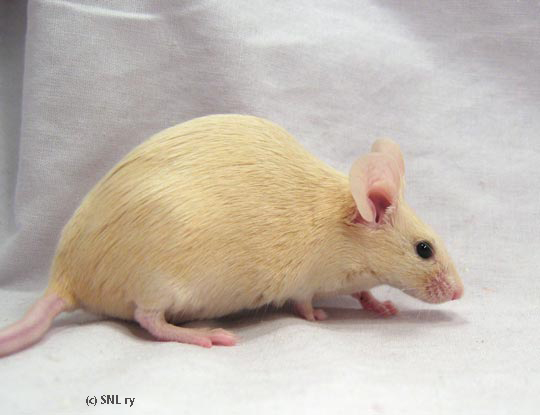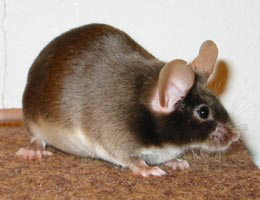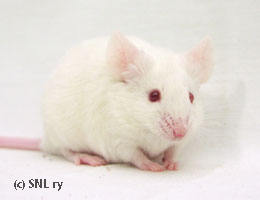Genetics
C-locus
3. Chinchilla dilution, cch
The chinchilla dilution gene is second in this series. It dilutes yellow pigment much more than it does the black pigment. However, it doesn't effect brown pigment at all. As I have already noted on the A-locus page, pink-eyed chinchillated varieties are rather tricky to breed, to say the least. This is because of the black-eyed gene and the chinchilla gene being linked, i.e. they are located in the same chromosome. Therefore, in order for a pink-eyed chinchillated variety to appear, there should be a brake in the chromosome and the "loose ends" should cross-connect. Of course, you can't see that this thing has happened just by looking at the mouse. This means that you need also quite a lot of luck!
3.1. Homozygous Form
3.1.1. cch with Ay
Chinchilla gene dilutes the red mouse into cream. Now we return to the creams, as you can see. These ones could be called the "phase two creams". This type of creams were bred from the 1930's on, as the colour was lighter than the older creams. However, due to the linkage of chinchilla and pink-eyed dilution genes, pink eyed creams became rare at this point.

Cream, Ay/* cch/cch p/p |

Chocolate fox, at/* b/b cch/cch |

a/a B/* cch/cch P/* |

a/a cch/cch p/p |
Remember, the "phase one creams" were genetically lilac reds (Ay/* bc/* d/d). The effect of chinchilla factor on red/chocolate/blue -combination was especially advantageous as regards of even and uniform pigmentation. However, these black Eyed creams still suffered from obesity and they didn't breed true. Neither do phase two creams, as they too are Ay/* and therefore always heterozygous in a-locus. This variety is called cream in Finnish standards and it is in Unstandardized class.
Marten sable is genetically chinchillated sable, Ay/* B/* cch/cch. In this variety, the red colour present in the sable is replaced by white in the martens, otherwise the shadings are similar and should be as dark as possible, emphasis on words "as dark as". The marten sable can never be as dark on the top as the sable is. The belly of marten should be pure white. The marten sable can also be bred in chocolate, blue and lilac varieties. Of these, the chocolate marten sable suffers from the same problems than the chocolate sable, but blue marten sable is rather charming. The lilac marten sable resembles a rabbit variety called smoke pearl.
3.1.2. cch with A
Double dose of chinchilla-gene together with A, A/A or A/a B/* cch/cch, is the genetic make-up of the grey agouti mouse. This is produced when the chinchilla gene dilutes the golden brown colour present in the agouti into ivory colour. As the chinchilla gene doesn't, according to my sources, have any effect on the brown pigment, chinchillated cinnamons A/* bc/* cch/cch would simply be grey cinnamon mice. Just replace mentions of silver grey and deep slate in the standards of the grey agouti with light chocolate and chocolate and you'd get the grey cinnamon. grey blue agouti, or blue grey agouti, would probably be just a "blued" version of the grey agouti.
3.1.3. cch with at
Chinchillated tans are what is called in standards foxes. With this combination, the tan belly is reduced to creamy to white. It does take some selective breeding to get the purest white belly. Just like selective breeding is needes to get the deepest tan belly. Standardized fox (or grey fox) varieties are black, chocolate, blue and lilac. With black fox the top colour is only slightly off-black, but that can't be easily seen. chocolate foxes have good top colour. The situation is the same with blue and lilac foxes. Do note, that foxes are not "ready in a snap of the fingers" -variety, like none of the mouse varieties are. The right white belly has to be bred for, otherwise it is just a cream belly, not so easily told apart from extremely poor tan belly (and I have seen these mice - you can't really say are they very poor foxes or very poor tans!).
3.1.4. cch with a
According to Silvers, chinchilllated black, a/a B/* cch/cch- mice are "best described as a medium shade of sepia" and the genotype can be called Sepia or "mock black". However, when it comes to selectively bred fancy mice, the genotype isn't that far from black. How much off-black the sepia mouse is, depends on the modifiers present. As the chinchilla gene has little to no effect on the brown pigment, a chinchillated self chocolate looks like a regular chocolate mouse, but with a colder shade. Chinchillated blue can be told apart from C/* blue only by the colour of faulty tan hairs on the mouse: C/* blue has tan hairs, cch/cch blue creamy to white. Chinchillated lilac (a/a bc/* d/d cch/cch) looks like a regular lilac. It can even be a better shade of lilac than C/* ones.
Chinchillated pink-eyed lilac, a/a bc/* d/d cch/cchpp, is - according to one source, actually pink Eyed White mouse, indistinguishable from albinos without test matings. Of course, it isn't very likely that you do get this variety because of the linking discussed above.
Quiz Time!
Quiz three: If chinchillation turns an agouti tan into chinchilla, how come there can be agouti fox mice?
Answer: Yes, the chinchilla gene would dilute the agouti top into chinchilla. Still, agouti fox is possible, but not with the normal way - chinchillating the tan into white belly. However, there is the white-bellied agouti gene Aw, which can cause mice that look like an agouti fox. When a friend of mine was trying to breed argente creme mice from chinchilla, he got lots of poor agouti fox mice. As these chinchilla mice were originally from English import lines, they probably had this gene...
